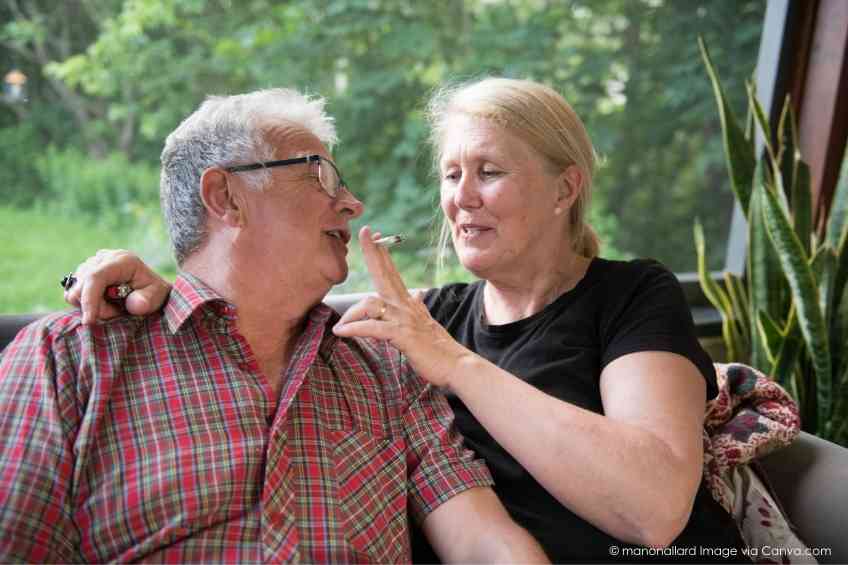By Jessica Scarpati –
From arthritis to insomnia, marijuana is becoming the go-to remedy for many older adults. A 2023 survey from the University of Michigan revealed that one in eight Americans, or 12 percent, aged 50 to 80 reported consuming a THC-containing substance in the past year. That is up from just 3 percent in 2006. But how well do rocking chairs and rolling papers mix? It ain’t reefer madness, but there are some critical caveats to using cannabis during one’s golden years.
“Older adults represent a vulnerable age group for cannabis use due to interactions with medications, risky driving, cannabis-related mental health impacts and increased possibility of falls and memory issues,” said Anne Fernandez, PhD, an addiction psychologist in the U-M Addiction Center, who led the national poll of more than 2,000 older adults.
The fallout of that is becoming visible in doctor’s offices and emergency rooms around the country. Research published this June in JAMA Open looking at Medicare claims between 2017 and 2022 found a gradually increasing rate of people 65 and older being diagnosed with “cannabis-related disorders”—defined as psychological symptoms or social impairments due to excessive marijuana use—during outpatient visits to their doctor.
Meanwhile, a 2023 study from the University of California (UC) San Diego revealed the rate of cannabis-related emergency room visits among California adults ages 65 and older skyrocketed by 1,808 percent from 2005 to 2019.
Now, before the pot-induced paranoia sets in, a few considerations: Authors of the first study noted that more people could be disclosing marijuana use and concerns to their doctor over that five-year period because there was less perceived stigma of doing so―not necessarily more danger to their health―as more states legalized the substance.
In its coverage of the UC San Diego study, The Washington Post pointed out that the study only cataloged that seniors sought emergency care―not that they were harmed.
“The study does not distinguish between life-threatening and benign cases, such as someone panicking at an unfamiliar sensation but recovering without issue after several hours,” the Post reported. “Some visits could be spurred by patients unwittingly eating a marijuana-laced edible and not realizing they’re high, or older people learning they can’t handle the high-potency products flourishing on the market today.”
Indeed, today’s weed is far more potent than it was during Haight-Ashbury’s Summer of Love and Woodstock. Canadian health officials note that, on average, dried cannabis contains four times more THC today than it did even just 40 years ago. Some cannabis extract products, such as tinctures placed under the tongue, even contain up to 30 times more THC than dried cannabis from the 1980s.
“Many patients assume they aren’t going to have adverse side effects from cannabis because they often don’t view it as seriously as they would a prescription drug,” noted geriatrician Benjamin Han, MD, MPH, first author of the UC San Diego study. “I do see a lot of older adults who are overly confident, saying they know how to handle it—yet as they have gotten older, their bodies are more sensitive, and the concentrations are very different from what they may have tried when they were younger.”
Another surprise side effect of toking up over the hill: Your body’s composition has fundamentally changed, making the high linger longer than you might expect.
“Cannabis is a fat-soluble substance, and with increasing age, you have more body fat relative to water,” explained Alison Moore, MD, MPH, chief of geriatrics, gerontology and palliative care at UC San Diego, in an American Medical Association podcast interview. “That means that cannabis sticks around your system longer than it would when you were younger.”
So, what are the risks of overdoing it? For older adults, it turns out that the hazards can be far more serious than munchies. Because THC affects the brain, people with dementia or anxiety can find excess use may worsen their symptoms, causing increased agitation or paranoia. Falls also becoming especially worrisome as people age. Weed’s impairment of balance and reaction time only increases those risks.
The danger of overuse is particularly acute for people who take blood thinners, anti-seizure medications and sedatives like Ambien or Xanax. It can also affect how a person’s body metabolizes anesthesia, making it critical to disclose marijuana use to your doctor prior to surgery.
“Cannabis has about 600 chemicals in it, and in theory, the two main active ingredients in cannabis, THC and CBD, could either increase or decrease the blood levels of other drugs you are taking by affecting the enzymes in your liver that help metabolize your medications,” explained Boston-based primary care physician Peter Grinspoon, MD, in Harvard Health Publishing. “CBD, in particular, is at risk for increasing the other drugs in your system by ‘competitively inhibiting’ (or, in plain English, using at the same time) the molecules that you need to break down and clear these medications from your body.”
In a 2023 study of hospitalized adults over 65 with existing cardiovascular risk factors―including high blood pressure, type 2 diabetes or high cholesterol―researchers from Nazareth Hospital in Philadelphia found that marijuana users who reported no tobacco use had a 20% higher risk of having a major heart or brain event, such as a heart attack or stroke, during their hospitalization compared to non-cannabis users.
There’s no arguing, however, that millions of Americans, including many older adults, find benefit and pleasure in using marijuana. This begs the question of how seniors can partake safely. Experts advise starting “low and slow,” choosing legal products with the lowest THC percentage or dose available. For edibles, capsules and lozenges, that’s 1 milligram to 2.5 milligram per unit. For dried cannabis, shoot for 10 percent THC per unit or lower.
“Older adults generally need less because their metabolism has slowed,” California-based nurse practitioner Eloise Theisen, MSN, NP, AGPCNP-BC, president of the American Cannabis Nurses Association, told The New York Times. “[Today’s products also] can have a delayed onset, so it’s easier to over-consume, especially with products that taste good.”










